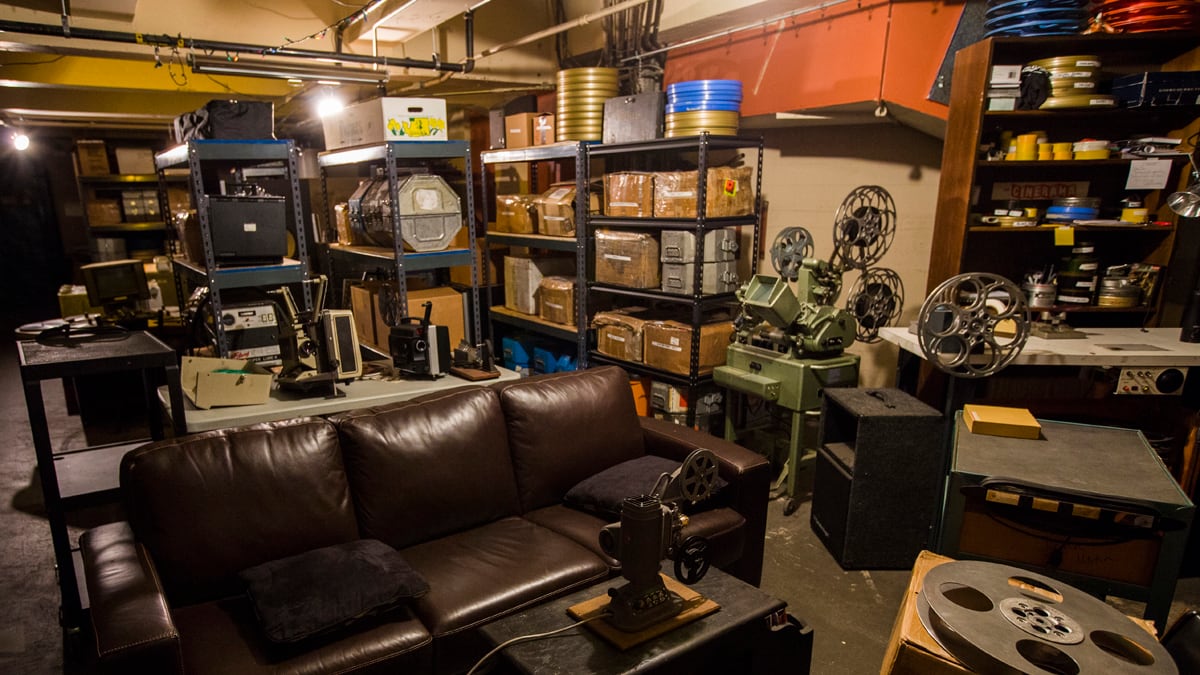Last March, at Hollywood Theatre, fans of Wu-Tang Clan were treated to a rare event: a live scoring of the 1978 martial arts classic The 36th Chamber of Shaolin, orchestrated by the group's de facto leader, RZA.
But the legendary rapper and producer got something even better, and rarer, out of his appearance—a tour of the theater's archive room.
"He lost his mind," says Dan Halsted, the Hollywood's head programmer.
Halsted, 41, is the owner of a coveted collection of kung fu films, which he stores in a dimly lit, subterranean space roughly the size of a small, one-bedroom apartment. What makes it so valuable and unique is not the quantity of the films but the quality. Some of the reels found in the cardboard boxes lining the room's metal shelves are the only known prints in existence, including a few that are foundational to the Wu-Tang universe: The Mystery of Chessboxing, 7 Grand Masters and Shaolin vs. Wu Tang, which he scored for $25 from a film vault in L.A. that didn't know what it had.
The archive is also what drew Quentin Tarantino to the theater three years ago, when he made a surprise appearance during a screening of The Hateful Eight. "He borrows my stuff all the time," Halsted says.
The collection is so prized Halsted requested that its exact location be kept secret, and there were certain films WW wasn't allowed to photograph. When you first walk in, though, the archive just looks like an archetypal stoner hideout: Movie posters line the walls, Christmas lights hang from the ceiling. Amid the packed shelves sits a worn-out couch.
But the details are jaw-dropping. Some of the collection was dug up through careful hunting, but a lot of it was found via "raids"—whenever an old theater closes, Halsted grabs whatever they'll let him take. It's all difficult to come by, and difficult to keep.
"You have to hate film as much as you love it before you can truly appreciate it," says Halsted. "It's such a pain in the ass."
Edison Projector

The Hollywood Theatre's projector collection includes a kinetoscope, or Edison projector, made during the silent film era. Halsted has been told his projector works, but he's never tried it for himself. The earliest commercial film stock has a nitrate base, which is highly flammable. "It kind of scares me a little bit," he says. "When nitrate catches on fire, it just burns till it's gone. You can throw it underwater and it still burns."
Film Repair Desk

Halsted often has to repair the sprockets on the movies in his archive—those are the square holes along the sides of a film that hook onto a projector's winders. He repairs each one manually with a splicer, a tool that's a little like a hole punch. Each frame has four sprockets on each side, and each film has about 24 frames per second. "It's a nightmare," Halsted says. "Some of those kung fu shows, people have no idea the work that went into it. That was days of work."
Ku-Fang: Il Ciclone di Hong-Kong Poster

When Tarantino visited the Hollywood in 2015, he gave Halsted a poster for the Italian version of Kung Fu Queen—a movie starring Angela Mao, one of the most famous female martial arts stars of all time—to thank him for his work as an archivist. The pair spent the rest of the night drinking across the street at the now-shuttered dive Blackwell's.
2001: A Space Odyssey on 70 mm

The Hollywood is the only theater in Oregon that can screen 70 mm film. In the age of digital projection and streaming services, it's a luxury and inconvenience most theaters can't afford: Collectively, the 10 reels that make up 2001, which Halsted began screening yearly in 2015, weigh about 400 pounds. The Hollywood had to rent the film for each screening until last year, when it raised $25,000 to buy its own, brand-new print from Warner Bros. Halsted hopes to add more 70 mm prints to Hollywood's collection; his dream is to find Die Hard in wide format.
Moviola

You can't stop or rewind a projector without burning a hole in the film, so editors would use Moviolas to view their works-in-progress. Like many things in the archive, it ended up at the Hollywood because someone was looking to get rid of it, and reached out to Halsted out of the blue. The machine arrived in pieces. Halsted learned how to put it together by watching a scene in 1981's Blow Out, in which John Travolta's character assembles one.
Hollywood Theatre Spring Highlights
Come to Daddy, Feb. 21
The Wiz, Feb. 24
Godzilla vs. King Kong on 35 mm, Feb. 25
The Future Is Now: Film Noir Hybrids for the Nervous Generation with Elliot Lavine, March 15-29
Fashion in Film: Grey Gardens, March 27
Willamette Week's Spring Arts Guide 2020
In Eyrst's Studio, Local Rappers Pull All-Nighters, and There's Artwork by the Nirvana Baby

